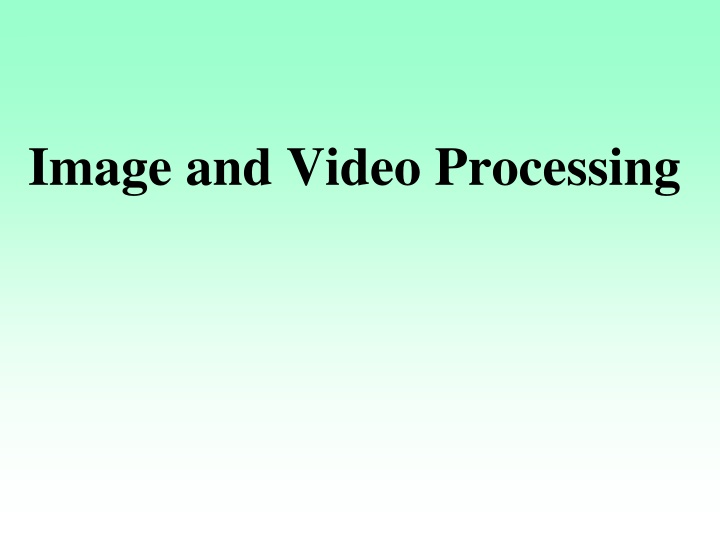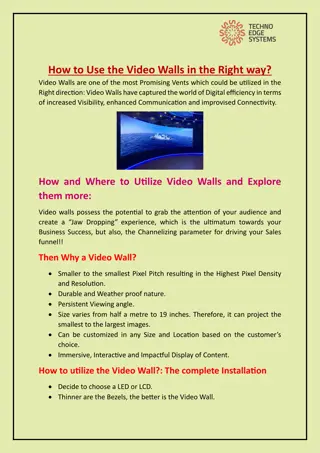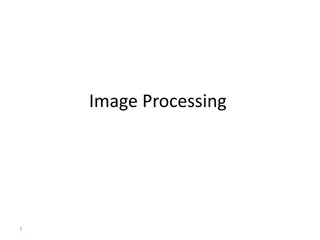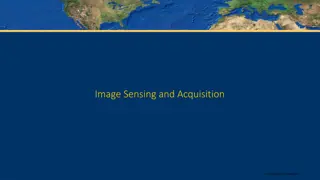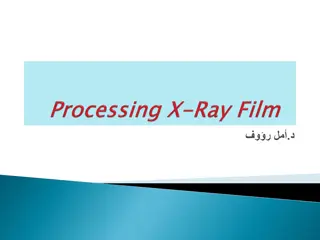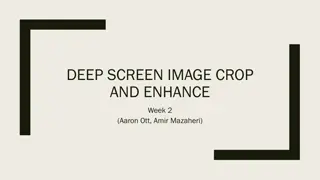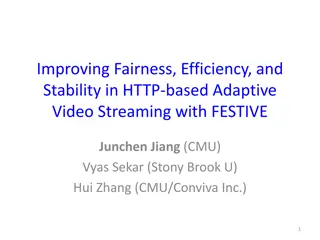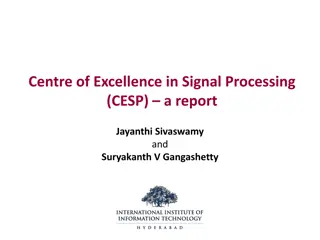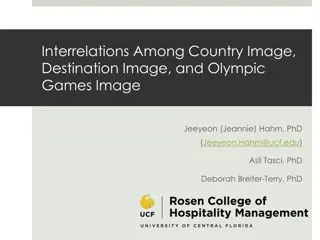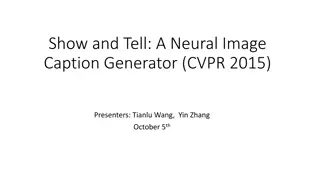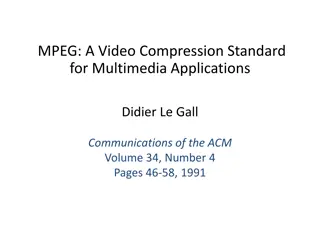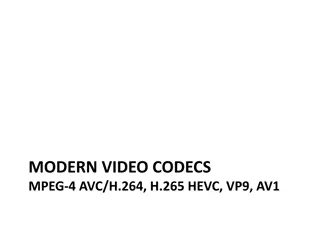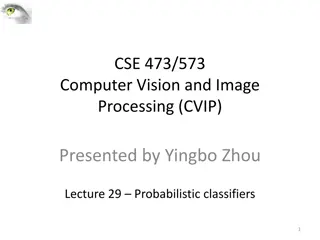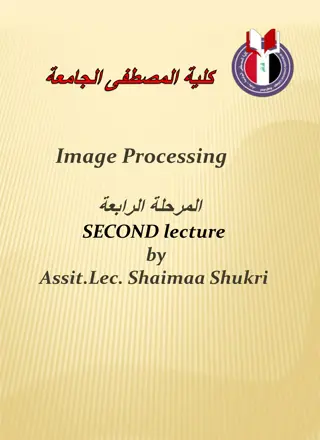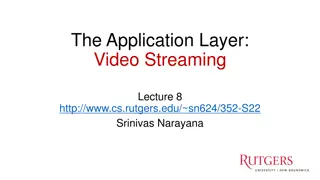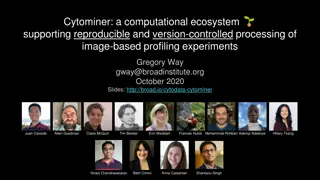Image and Video Processing
In the field of image processing, understanding and applying basic methods for image restoration and blur identification are crucial. This involves restoring degraded images caused by various factors like motion blur, out-of-focus blur, and atmospheric turbulence. By utilizing algorithms such as Inverse Filter, Least-Squares Filters, and Spectral Blur Estimation, the aim is to reconstruct the original image from blurred and noisy versions. The process also involves recognizing different blur models, like linear motion blur and uniform out-of-focus blur. Dive into the world of image restoration to enhance your understanding of image processing techniques.
Download Presentation

Please find below an Image/Link to download the presentation.
The content on the website is provided AS IS for your information and personal use only. It may not be sold, licensed, or shared on other websites without obtaining consent from the author.If you encounter any issues during the download, it is possible that the publisher has removed the file from their server.
You are allowed to download the files provided on this website for personal or commercial use, subject to the condition that they are used lawfully. All files are the property of their respective owners.
The content on the website is provided AS IS for your information and personal use only. It may not be sold, licensed, or shared on other websites without obtaining consent from the author.
E N D
Presentation Transcript
III.5 Basic Methods for Image Restoration and Identification 1 Introduction 2 Blur Models 2.1 No Blur 2.2 Linear Motion Blur 2.3 Uniform Out-of-Focus Blur 2.4 Atmospheric Turbulence Blur 3 Image Restoration Algorithms 3.1 Inverse Filter 3.2 Least-Squares Filters 3.3 Iterative Filters 4 Blur Identification Algorithms 4.1 Spectral Blur Estimation 4.2 Maximum-Likelihood Blur Estimation
1 Introduction Image Degration What s image degration? Recorded image invariably represents a degraded version of the original scene. The undoing of these imperfections is crucial to many of the subsequent image processing tasks. There exists a wide range of different degradations that have to be taken into account, covering for instance noise, geometrical degradations, imperfections and blur. What s the reason for degration? It can be caused by relative motion between the camera and the original scene, or by an optical system that is out of focus. When aerial photographs are produced for remote sensing purposes, blurs are introduced by atmospheric turbulence( ), aberrations( ) in the optical system. illumination and color
Introduction Image restoration a)the image with Sinusoidal noise b) the image after restoration ( )ddddddddddddddddddddd with butterworth filter
Introduction Image restoration a)the image degraded by atmospheric turbulence d ddddddddddddddddddd b) the image after restoration with wiener filter
Introduction Image restoration The field of image restoration (sometimes referred to as im- age deblurring or image deconvolution) is concerned with the reconstruction or estimation of the uncorrupted image from a blurred and noisy one. Image restoration often uses some priori to establish a . Then it tries to perform an operation on the blurred image that is the inverse of the imperfections in the image degrading system. degrading system.
Introduction Degrading system Image degration Image restoration f(x,y): ideal image H(x,y): degration system n(x,y): noise g(x,y): the blurred and noisy image g(x,y) H [f (x,y)]+n(x,y)
Introduction Blur identification In the use of image restoration methods, the characteristics of the degrading system and the noise are assumed to be known as priori. In practical situations, however, one may not be able to obtain this information directly from the image formation process. The goal of blur identification is to estimate the attributes of the imperfect imaging system from the observed degraded image itself prior to the restoration process. The combination of image restoration and blur identification is often referred to as blind image deconvolution.
Introduction Linear spatially invariant degradation H is a linear function. ( 1 1 H k f x y ) ( ) ( ) ( ) + = + , , , , k f x y k Hf x y k Hf x y 2 2 1 2 2 H does not vary spatially. H [f(x- ,y- )] = g(x- ,y- ) The statistical properties (mean and correlation function) of the image and noise do not change spatially.
Introduction Spatial domain model Fourier domain model
III.5 Basic Methods for Image Restoration and Identification 1 Introduction 2 Blur Models 2.1 NoBlur 2.2 Linear Motion Blur 2.3 Uniform Out-of-Focus Blur 2.4 Atmospheric Turbulence Blur 3 Image Restoration Algorithms 3.1 Inverse Filter 3.2 Least-Squares Filters 3.3 Iterative Filters 4 Blur Identification Algorithms 4.1 Spectral Blur Estimation 4.2 Maximum-Likelihood Blur Estimation
2 Blur models Point-spread function 3 constraints: d(x, y) takes on nonnegative values only, because of the physics of the underlying image formation process; when real-valued images are dealt with the point-spread function d(x, y) is real-valued too; the imperfections in the image formation process are modeled as passive operations on the data, i.e, no energy is absorbed or generated.
2 Blur models 2.1 No blur PSF is modeled as a unit pulse: However, this can never be satisfied theoretically.
2 Blur models 2.2 Linear motion blur Many types of motion blur can be distinguished, all of which are due to relative motion between the recording device and the scene. This can be in the form of a translation, a rotation, a sudden change of scale, or some combinations of these. Here only the important case of a global translation will be considered. Uniform motion in a straight line is the most general and common one of all the motion blurs. Others can be regarded as piecewise Uniform motion in a straight line.
2 Blur models 2.2 Linear motion blur Vvelocity: the constant velocity at which the scene to be recorded translates relative to the camera. : the scene to be recorded translates relative to the camera under an angle of radians with the horizontal axis. texposure: the exposure interval. L: length of motion, L= Vvelocity *texposure
2 Blur models 2.2 Linear motion blur Motion blurred image is actually the superposition( ) of the same scenery image after a series of distance delay: PSF is given by:
2 Blur models 2.2 Linear motion blur The discrete version of this PSF is not easily captured in a closed form expression in general. For the special case that + = 0, , an appropriate approximation is:
2 Blur models 2.2 Linear motion blur Matlab implementation: fspecial( motion ,LEN,THETA) It returns a filter to approximate, once convolved with an image, the linear motion of a camera by LEN pixels, with an angle of THETA degrees in a counter-clockwise direction. The filter becomes a vector for horizontal and vertical motions. The default LEN is 9, the default THETA is 0, which corresponds to a horizontal motion of 9 pixels.
2 Blur models 2.3 Uniform Out-of-Focus Blur
2 Blur models 2.3 Uniform Out-of-Focus Blur d: diameter of defocus D:diameter of lens v0:image distance
2 Blur models 2.3 Uniform Out-of-Focus Blur The diameter of defocus depends on : 1.D:diameter of lens 2.v0:image distance 3.f: the focal distance 4.u:the object distance
2 Blur models 2.3 Uniform Out-of-Focus Blur When a camera images a three-dimensional (3-D) scene onto a 2-D imaging plane, some parts of the scene are in focus while other parts are not. If the aperture( ) of the camera is circular, the image of any point source is a small disk, known as the circle of confusion (COC). However, if the degree of defocusing is large relative to the wavelengths considered, a geometrical approach can be followed resulting in a uniform intensity distribution within the COC, named uniform out-of focus blur.
2 Blur models 2.3 Uniform Out-of-Focus Blur The spatially continuous PSF of this uniform out-of-focus blur with radius R is given by: Also for this PSF the discrete version d(n1, n2) is not easily arrived at. A coarse approximation is the following spatially discrete PSF: where C is a constant that must be chosen so that the integration of d is equal to 1 .
2 Blur models 2.3 Uniform Out-of-Focus Blur Matlab implementation: fspecial( disk ,RADIUS) It returns a circular averaging filter (pillbox) within the circle square with RADIUS. The default RADIUS is 5.
2 Blur models 2.4 Atmospheric Turbulence Blur The point-spread function can be described reasonably well by a Gaussian function: G:determines the amount of spread of the blur C:C is to be chosen so that the integration of d is equal to 1.
2 Blur models 2.4 Atmospheric Turbulence Blur The discrete version of the PSF is usually obtained by first computing a one-dimensional (1-D) discrete Gaussian PSF .For each PSF element ,the 1-D continuous PSF is integrated over the area covered by the 1-D sampling grid, namely [n - , n + ]: The spatially discrete approximation is then given by:
2 Blur models 2.4 Atmospheric Turbulence Blur
III.5 Basic Methods for Image Restoration and Identification 1 Introduction 2 Blur Models 2.1 NoBlur 2.2 Linear Motion Blur 2.3 Uniform Out-of-Focus Blur 2.4 Atmospheric Turbulence Blur 3 Image Restoration Algorithms 3.1 Inverse Filter 3.2 Least-Squares Filters 3.3 Iterative Filters 4 Blur Identification Algorithms 4.1 Spectral Blur Estimation 4.2 Maximum-Likelihood Blur Estimation
3.Image Restoration Algorithms What to do? In this section we will assume that the PSF of the blur is satisfactorily known. If the point-spread function of the linear restoration filter, denoted by h(n1, n2), has been designed, the restored image is given by or in the spectral domain by The objective of this section is to design appropriate restoration filters h(n1, n2) or H(u, v)
3.Image Restoration Algorithms How to measure? Quantitative judgment: In image restoration the improvement in quality of the restored image over the recorded blurred one is measured by the signal-to-noise ratio(SNR) improvement. Visual judgment In image restoration the improvement in quality of the restored image over the recorded blurred one is measured by the observers eyes.
3.Image Restoration Algorithms The signal-to-noise-ratio of the recorded (blurred and noisy) image is defined as follows: The signal-to-noise ratio of the restored image is similarly defined as Then, the improvement in signal-to-noise ratio (SNR) is Attention: Often, f(n1, n2) is not available. So only the visual judgment can be relied upon.
3.Image Restoration Algorithms 3.1 Inverse Filter An inverse filter is a linear filter, whose point-spread function hinv(n1, n2) is the inverse of the blurring function d(n1, n2).
3.Image Restoration Algorithms 3.1 Inverse Filter If the noise is absent, the second term above disappears so that the restored image is identical to the ideal image. The inverse filter may not exist because D(u,v) is zero at selected frequencies. This happens for both the linear motion blur and the out-of-focus blur described in the previous section. Even if the blurring function s spectral representation D(u,v) doesn t actually go to zero but becomes small, the second term -known as the inverse filtered noise-will become very large.
3.Image Restoration Algorithms 3.1 Inverse Filter Fig. (a) shows an image degraded by out-of-focus blur (R = 2.5) and noise. The inverse filtered version is shown in Fig. (b), clearly illustrating its uselessness
3.Image Restoration Algorithms 3.2 Least-Squares Filters For the noise sensitivity of the inverse filter to be overcome, a number of restoration filters have been developed; these are collectively called least-squares filters. We describe the two most commonly used filters, namely the Wiener filter and the constrained least-squares filter.
3.Image Restoration Algorithms 3.2 Least-Squares Filters 3.2.1 Wiener filter The Wiener filter is a linear spatially invariant filter ,in which the point-spread function h(n1, n2) is chosen such that it minimizes the mean-squared error (MSE) between the ideal and the restored image.
3.Image Restoration Algorithms 3.2.1 Wiener filter The solution of this minimization problem is known as the Wiener filter, and it is easiest defined in the spectral domain: Here D* (u, v) is the complex conjugate( ) of D(u,v), and Sf(u, v) and Sw(u,v) are the power spectrum( ) of the ideal image and the noise, respectively. The power spectrum is a measure for the average signal power per spatial frequency carried by the image. Often the solutions to Sf(u, v) and Sw(u,v) are difficult to get, so we use a constant to replace ( ).
3.Image Restoration Algorithms Wiener filter vs. Inverse filter In the noiseless case we have Sw(u,v) = 0, so that the Wiener filter approximates the inverse filter. If the recorded image is noisy, the Wiener filter trades off the restoration by inverse filtering and suppression of noise for those frequencies where D(u,v) approximates 0. 1 D(u,v)=0, but Sw(u,v) not equals to 0 2 when SNR is high, , , approaches the inverse filter 3 when SNR is small, , it acts as a frequency rejection filter, i.e. Hwiener(u,v) approximates 0.
3.Image Restoration Algorithms 3.2.1 Wiener filter Matlab implementation: J = DECONVWNR(I,PSF) J = DECONVWNR(I,PSF,NSR) J = DECONVWNR(I,PSF,NCORR,ICORR) where NSR is the noise-to-signal power ratio. Default is 0. NCORR and ICORR are the autocorrelation functions of the noise image and the original image.
3.Image Restoration Algorithms 3.2.1 Wiener filter
3.Image Restoration Algorithms 3.2 Least-Squares Filters 3.2.2 Constrained least-squares filter( ) Inverse filter: excessive noise amplification Wiener filter: estimation of the power spectrum of the ideal image Constrained least-squares filter The difference between the blurred version of restored image and the distorted one should equal to noisy data. Select the solution that is as smooth as possible
3.Image Restoration Algorithms 3.2 Least-Squares Filters 3.2.2 Constrained least-squares filter The difference between the blurred version of restored image and the distorted one should equal to noisy data. Wiener filter tries to make the blurred version of the restored image equal to the recorded distorted image. But there exists noise. So constrained least-squares filter make this regular.
3.Image Restoration Algorithms 3.2 Least-Squares Filters 3.2.2 Constrained least-squares filter Select the solution that is as smooth as possible. Here, c(n1, n2) represents the point-spread function of a 2-D high-pass filter. A typical choice for c(n1, n2) is the discrete approximation of the second also known as the 2-D Laplacian operator. The interpretation is that it gives a measure for the high-frequency content of the restored image. Minimizing this measure will make the restored image have as little high-frequency content as possible.
3.Image Restoration Algorithms 3.2 Least-Squares Filters 3.2.2 Constrained least-squares filter Minimize: Subject to:
3.Image Restoration Algorithms 3.2 Least-Squares Filters 3.2.2 Constrained least-squares filter The solution: Here is a tuning or regularization parameter which makes the constraint satisfied. Though analytical approaches exist to estimate , the regularization parameter is usually considered user tunable.
3.Image Restoration Algorithms 3.2 Least-Squares Filters 3.2.2 Constrained least-squares filter Wiener filter & constrained least-squares filter It should be noted that although their motivations are quite different, the formulation of the Wiener filter and constrained least- squares filter are quite similar. Indeed these filters perform equally well, and they behave similarly in the case that the variance of the noise approaches zero.
